By Michael E. Haskew
It was a bold prediction. “Rough but fast … We’ll be through in three days. It might only take two.”
Major General William H. Rupertus, commander of the 1st Marine Division, was confident of a swift victory once his veterans assaulted the island of Peleliu in the Palaus.
Nicknamed “the Old Breed,” the 1st Marine Division had earned its reputation as a formidable fighting unit at Guadalcanal and Cape Gloucester earlier in the Pacific War. Pulled back to tiny Pavuvu in the Russell Islands for rest and resupply, the division received replacements and new equipment, although there remained some materiel shortages.
By late summer 1944, the 1st Marine Division had been deployed to the Pacific for nearly two years. The drive toward the Japanese home islands had been costly but successful thus far. As Admiral Chester Nimitz’s island-hopping across the Central Pacific and General Douglas MacArthur’s advance toward the Philippines converged, however, a difference of strategic opinion emerged between the commanders.
While Nimitz favored the capture of Formosa and then a move against Okinawa, MacArthur, for both strategic and sentimental reasons, wanted to return to the Philippines first and then strike at Okinawa. Either way, the eventual control of Okinawa would provide an essential staging area for the invasion of Japan.
The final strategic decision for the continued offensive in the Pacific went all the way to the White House. President Franklin D. Roosevelt flew to Hawaii in July 1944 to confer with both senior commanders. The President chose MacArthur’s proposal, and Nimitz pledged to protect his right flank during the coming offensive.
The high-level decision thrust the tiny island of Peleliu, only five square miles in area and shaped like a lobster claw, at the forefront of Allied planning.
A speck of land in the Palaus group about 600 miles east of the Philippines, Peleliu lies near the western end of the Caroline Archipelago, which stretches 1,000 miles across the Central Pacific.
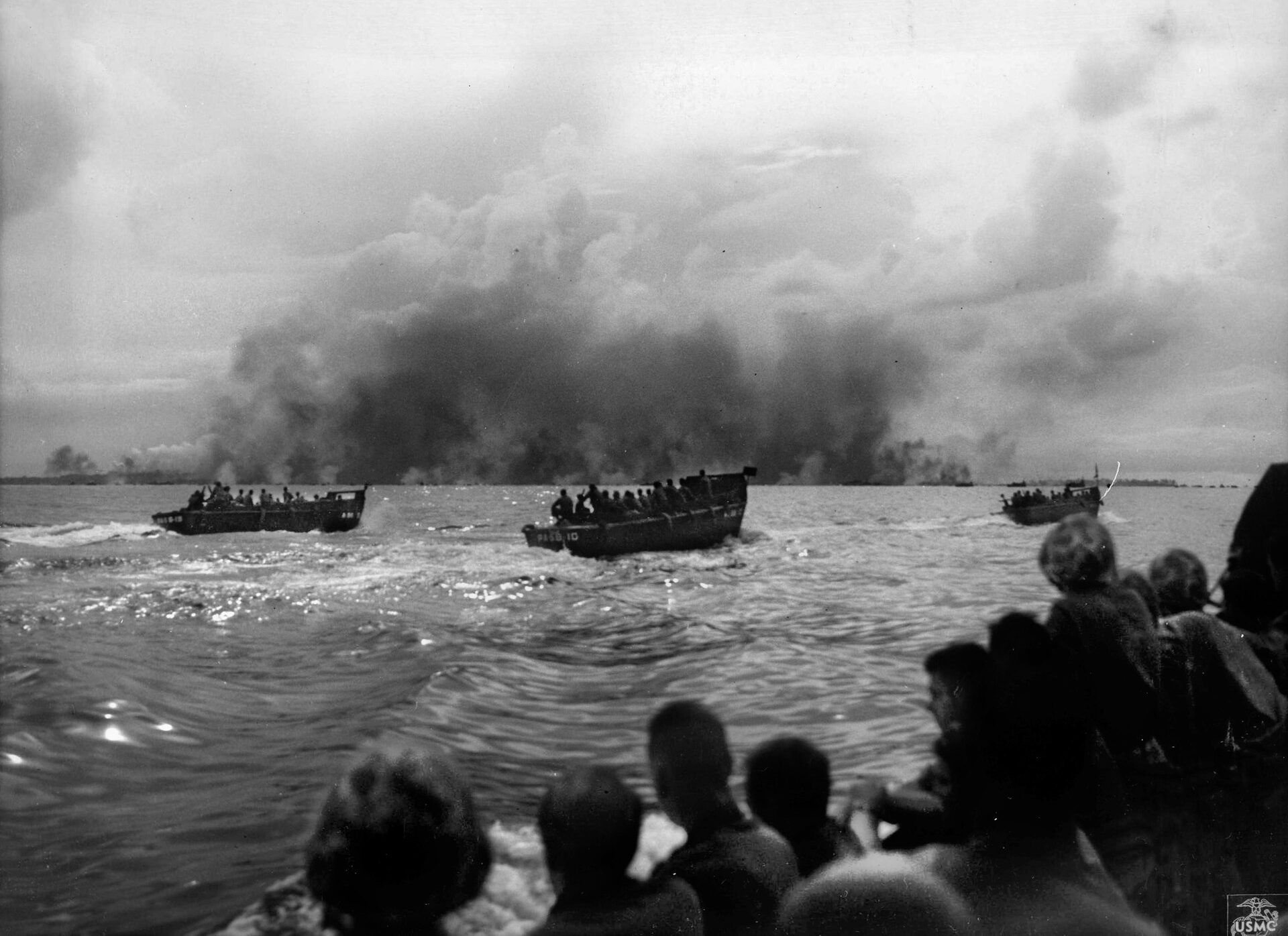
An enemy airstrip on Peleliu, and another on the nearby island of Ngesebus, concerned MacArthur; they presented the threat of aerial attacks against his troop-transport and supply lines to the Philippines. Nimitz concurred, and plans were developed for Operation Stalemate II—the capture of Peleliu, Ngesebus, and the island of Angaur, about six miles to the southwest.
But rather than the quick victory on Peleliu predicted by General Rupertus, the 1st Marine Division and the U.S. Army’s 81st Infantry Division, commanded by Maj. Gen. Paul Mueller, were to experience some of the most bitter fighting of the Pacific War during Stalemate II, and the bloody campaign remains one of the most controversial of World War II.
Several major elements contributed to the ferocious nature of the combat at Peleliu. Among these was the failure of American reconnaissance flights and photo analysis to accurately assess the rugged terrain—a jumble of deep draws, canyons, and mountains dotted with heavily fortified caves, their entrances concealed by thick jungle.
Another factor, likely the most significant, was a profound change in Japanese strategic and tactical defensive philosophy. Previous Marine and Army amphibious landings had been met with fierce opposition at the water’s edge. Spirited banzai attacks followed, with the persistent expectation that the Americans would be driven back into the sea. After the anticipated results had failed to materialize, the Japanese adopted a new concept of defense-in-depth. The beaches would be contested, but the object would now be to draw the Americans inland, engaging them in a protracted battle of attrition and exacting the highest possible toll in American blood, making the conquest of further Japanese-occupied territory so costly that the enemy would tire of war and sue for peace. The battle for Peleliu would mark the debut of the new Japanese defensive plan.
Delays in the capture of the Marianas extended the timetable for the Peleliu operation and exacerbated a debate as to whether the invasion of the island was necessary at all. Some contemporary observers, among them Admiral William F. “Bull” Halsey, commander of the U.S. Third Fleet, believed it was unnecessary. Modern historians have also continued to debate the judgment of both McArthur and Nimitz; however, considering the information available at the time, it can convincingly be argued that the two senior commanders acted properly.
On the eve of the Peleliu assault, Halsey approached Nimitz with a recommendation to cancel the operation and instead accelerate the invasion of the Philippines, first hitting the beaches on the central island of Leyte in October, two months earlier than the originally planned invasion of the southern island of Mindanao. The Leyte-invasion portion of Halsey’s recommendation was adopted, but the Peleliu landing would proceed as planned.
The Peleliu assault would be preceded by an intense naval and air bombardment. The five old battleships Pennsylvania, Tennessee, Maryland, Idaho, and Mississippi led a contingent of cruisers and destroyers that were to pound Peleliu for three days before the landings. Aircraft from three fleet carriers and eight light and escort carriers were also to attack targets ashore.
When the task of executing Operation Stalemate II was handed to Marine Major General Roy S. Geiger’s III Amphibious Corps (consisting of the 1st Marine Division and the 81st Infantry Division), the executive officer of the 1st Marine Division, Brig. Gen. Oliver P. Smith, led the planning effort, while Rupertus was in Washington, D.C., for an extended period. Early on the morning of September 15, 1944, three Marine regiments—the 1st under Colonel Lewis B. “Chesty” Puller, the 5th commanded by Colonel Harry D. “Bucky” Harris, and the 7th led by Colonel Herman H. Hanneken—were to assault a 2,200-yard stretch of sand at the southwest corner of Peleliu Island. From there, the Marines would drive due east toward one of their primary objectives, Peleliu’s airfield. The artillery of the 11th Marines and the III Amphibious Corps were to begin landing within an hour of the assault.
From north to south, the invasion beaches were designated White 1 and 2, where the 1st Marines would hit the beach; Orange 1 and 2, the responsibility of the 5th Marines; and Orange 3, where the 7th Marines were to come ashore. Once clear of the beaches, Puller was to advance eastward and then pivot northward to attack the southwestern end of the formidable Umurbrogol Mountains while moving steadily northward along the coast. The 1st Battalion, 5th Marines was to provided flank protection as the 2nd Battalion, 5th Marines crossed the island to the east and took the airfield. The 7th Marines were to drive east and then south, isolating and annihilating enemy resistance.
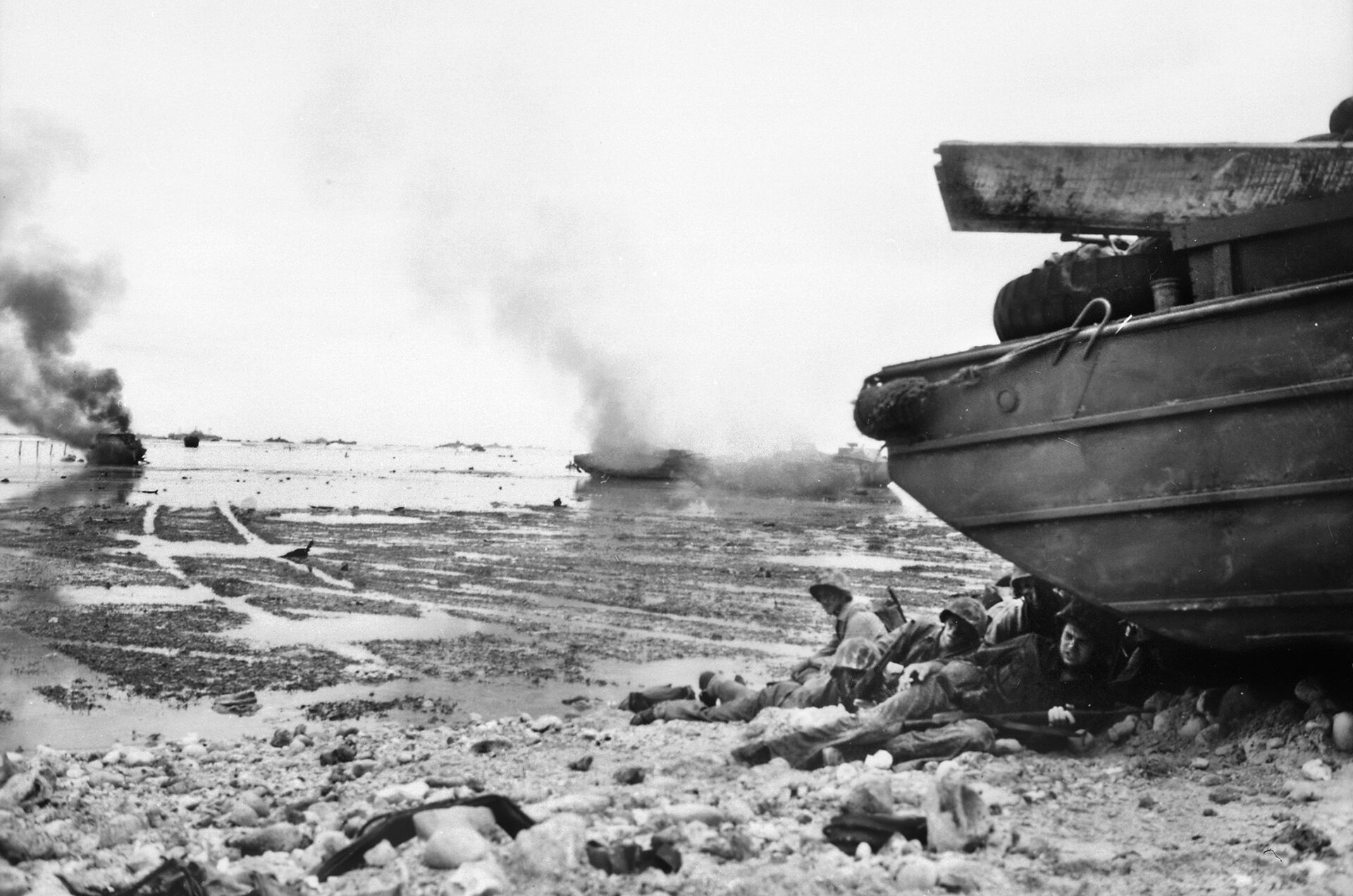
Meanwhile, the 81st Division’s 322nd Regimental Combat Team was to capture Angaur with the support of the 321st Infantry Regiment and then revert to III Amphibious Corps as a reserve. Altogether, more than 40,000 Marines and soldiers were made available for Operation Stalemate II, nominally brining to bear a substantial superiority in manpower. Despite this apparent advantage, however, Colonel Puller observed that only about 9,000 true riflemen populated the ranks of the 1st Marine Division; the rest were support personnel and other noncombat specialists.
The Japanese defenses on Peleliu were formidable. Colonel Kunio Nakagawa commanded the 2nd Infantry Regiment and two battalions of the 15th Infantry Regiment from the veteran 14th Division. Many of these soldiers had fought with the Kwantung Army in China, and there were at least 10,000 of them. The Japanese had also been preparing their defensive positions for many months—a labyrinth of caves and tunnels had been blasted from the rock of the Umurbrogol, and many of these strongholds were protected with sliding steel doors that made them virtually impossible to detect from the air. Heavy guns, mortars, and machine-gun nests with interlocking fields of fire were placed in concealed positions. Aerial bombs were rigged with tripwires and set as mines across potential invasion beaches. More than 500 caves, some extending several levels below ground, had been fortified by the eve of the American invasion.
The 3rd Battalion, 1st Marines, commanded by Lt. Col. Stephen V. Sabol, came ashore first, at 8:32 a.m. on September 15, 1944, on the far-left flank of White Beach 1. Enemy fire was accurate and intense, particularly against Sabol’s command, and the destructive enemy barrage expanded rapidly along the beachhead. Within an hour, scores of landing craft and other vehicles had been disabled or demolished, including numerous LVTAs—amphibious tractors equipped with 75mm guns designed to blast enemy strongpoints. Twenty-six LVTs were destroyed during the first 10 minutes of close combat. Puller’s LVT took a direct hit, and he barely escaped with his life.
While the 2nd Battalion, 1st Marines penetrated 350 yards inland and linked up with the 5th Marines on its right, Sabol’s 3rd Battalion struggled from the beginning. Just 100 yards off the beach, it ran into a 30-foot coral ridge topped with strong defenses, particularly a 47mm gun that pounded the Marines continually. Nicknamed “the Point,” this troublesome high ground had to be taken, and the task fell to Company K, 3rd Battalion, under Captain George P. Hunt.
After the war, Hunt became a managing editor with Life magazine, but on this day, he was preoccupied with staying alive and keeping his Marines focused on the Point. It had not been identified on any maps of Peleliu, and its existence proved to be the first of many nasty surprises the Marines encountered on the island.
Captain Hunt’s well-trained men moved forward, attempting to flank the incessantly firing gun embrasure and then silence it with demolition charges and rifle grenades. A Marine corporal named Anderson fired a rifle grenade that ricocheted off the muzzle of a Japanese gun, careened into the bunker, and set off a series tremendous explosions inside the blockhouse, demolishing the 47mm and several other guns positioned inside. Enemy soldiers poured from the blockhouse, their clothes flaming and rounds of ammunition cooking off in their belts. The Marines shot them down as they ran.
By afternoon, Company K held the Point, but it had been reduced to only platoon strength. Still, Hunt’s Marines beat back vicious counterattacks over the next 30 hours. When they were finally relieved, the colonel counted only 18 men able to shoulder a rifle. Company K had been torn to pieces; of its original 235 riflemen, only 78 Marines survived the ordeal.
The 5th Marines advanced steadily through coconut groves and jungle, reaching its first objective within an hour of the landings. By that afternoon, it had also reached the airfield. The 7th Marines absorbed heavy enemy fire at Orange Beach 3, and several landing craft were diverted to Orange Beach 2. The 3rd Battalion, 7th Marines advanced 500 yards before meeting a line of pillboxes and concrete blockhouses near an old Japanese barracks. Tank support was misdirected, creating a gap between adjoining elements that required a halt to reestablish coordination. As a result, it took nearly six hours for Lt. Col. John Gormley’s 1st Battalion, 7th Marines to reach its objective.
Rupertus, monitoring the progress of the 1st Division, became concerned that its momentum was waning. He committed the last of his reserve, the 2nd Battalion, 7th Marines, in the afternoon. As the 5th Marines consolidated its hold on the airfield, Nakagawa launched a counterattack just before 5 PM, spearheaded by about 15 Type-95 light tanks supported by infantry.
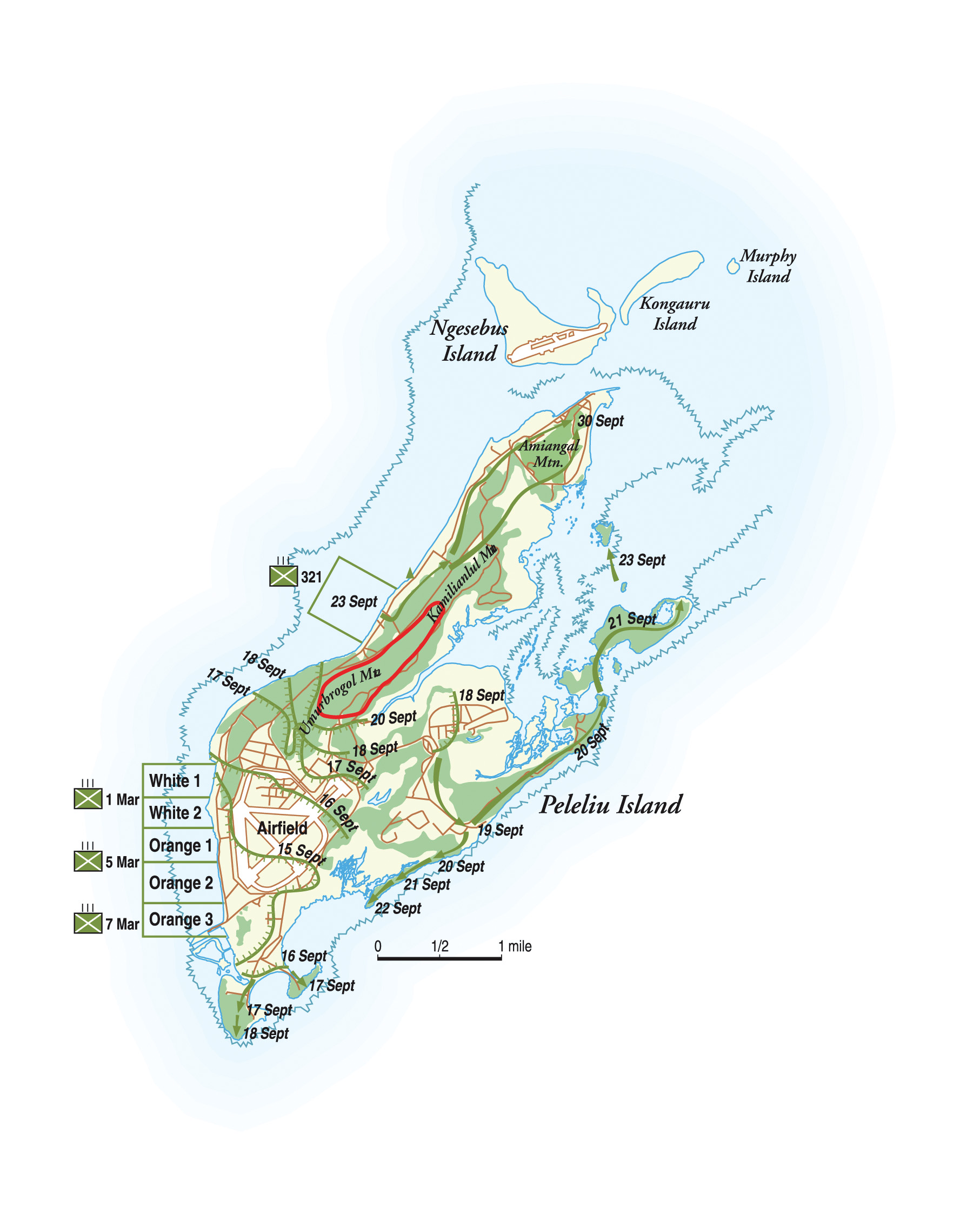
Moving north to south, the Japanese stumbled into a prepared defensive line and soon came under fire from both the 1st and 5th Marines. One Marine destroyed a pair of enemy tanks with a bazooka, while the M4A1 Sherman tanks of the 1st Tank Battalion flanked the Japanese and raked the inferior enemy armor with 75mm fire. Within minutes, most of the Japanese tanks were engulfed in flame. They had also outdistanced their infantry, leaving the Japanese foot soldiers exposed to withering American small-arms and artillery fire. The Japanese counterattack foundered and collapsed.
Although the Marines had secured a foothold on Peleliu, the Americans had not reached all of the objectives planned for the first day of Stalemate II. After dark, the Japanese mounted numerous counterattacks; one of these, against the 7th Marines, was repulsed with the help of a black Marine support unit that volunteered to take up rifles and moved inland from the beach.
Puller’s 1st Marines had suffered heavy casualties, and its hold on the Point was tenuous. The colonel’s report to Rupertus was overly optimistic, due primarily to his limited comprehension of the tactical situation in the confused battle. During the first day of combat, the 1st Marine Division had lost 1,111 casualties, including 209 killed in action. It was only the beginning of the bloodshed.
The 5th and 7th Marines continued their advance during the following week as temperatures soared above 100 degrees Fahrenheit. Steadily destroying pillboxes, blockhouses, and machine-gun nests, the 7th Marines secured southern Peleliu on September 18.
The 5th Marines captured the area around the airfield on September 16 and encountered heavy enemy fire across a patch of open ground to the north.
The 2nd Battalion became locked in a savage fight with Japanese strongpoints in a swampy area to the east. As they moved north to support the 1st Marines the following day, elements of the 2nd Battalion took flanking fire from enemy strongpoints in front of the 1st Marines’ positions. Heavy jungle vegetation impeded progress, but the 5th Marines forged ahead, reaching the eastern shore on of the island on September 20. Enemy resistance in southern Peleliu effectively ended on the 23rd.
On the left flank, meanwhile, the ordeal of Puller’s 1st Marines was becoming painfully obvious. On the second day, Puller was obliged to come to the aid of Hunt’s Company K, 3rd Battalion, at the Point and then take on the Japanese in a desperate assault northward through the dense jungle toward the ridges, valleys, and rocky crags of the Umurbrogol pocket. It was apparent to those on the ground that the thick canopy of jungle had obscured the nature of the Umurbrogol from aerial reconnaissance, and Puller’s command would consequently pay a bloody butcher’s bill.
On September 17, the 1st Marines encountered the rough terrain of the Umurbrogol for the first time. They soon found that the capture of one promontory meant subjecting themselves to direct fire from the next high ground to the north. Attacking on a front approximately 1,000 yards wide, the Marines engaged in a frustrating, bloody, time-consuming effort to blast the Japanese from every cave, defile, and peak of the Umurbrogol, which they nicknamed “Bloody Nose Ridge.”
During five days of intense fighting from the beaches into the labyrinth of Bloody Nose Ridge, the 1st Marines suffered 1,749 casualties, just six fewer than the entire 1st Marine Division had absorbed during the battle for Guadalcanal a year earlier. All the while, Rupertus continued to urge Puller forward, insisting that the drive maintain critical momentum. Rupertus refused to accept the idea that reinforcements from the 81st Division were needed. He ordered the Army division to proceed with the planned invasion of Angaur on September 17.
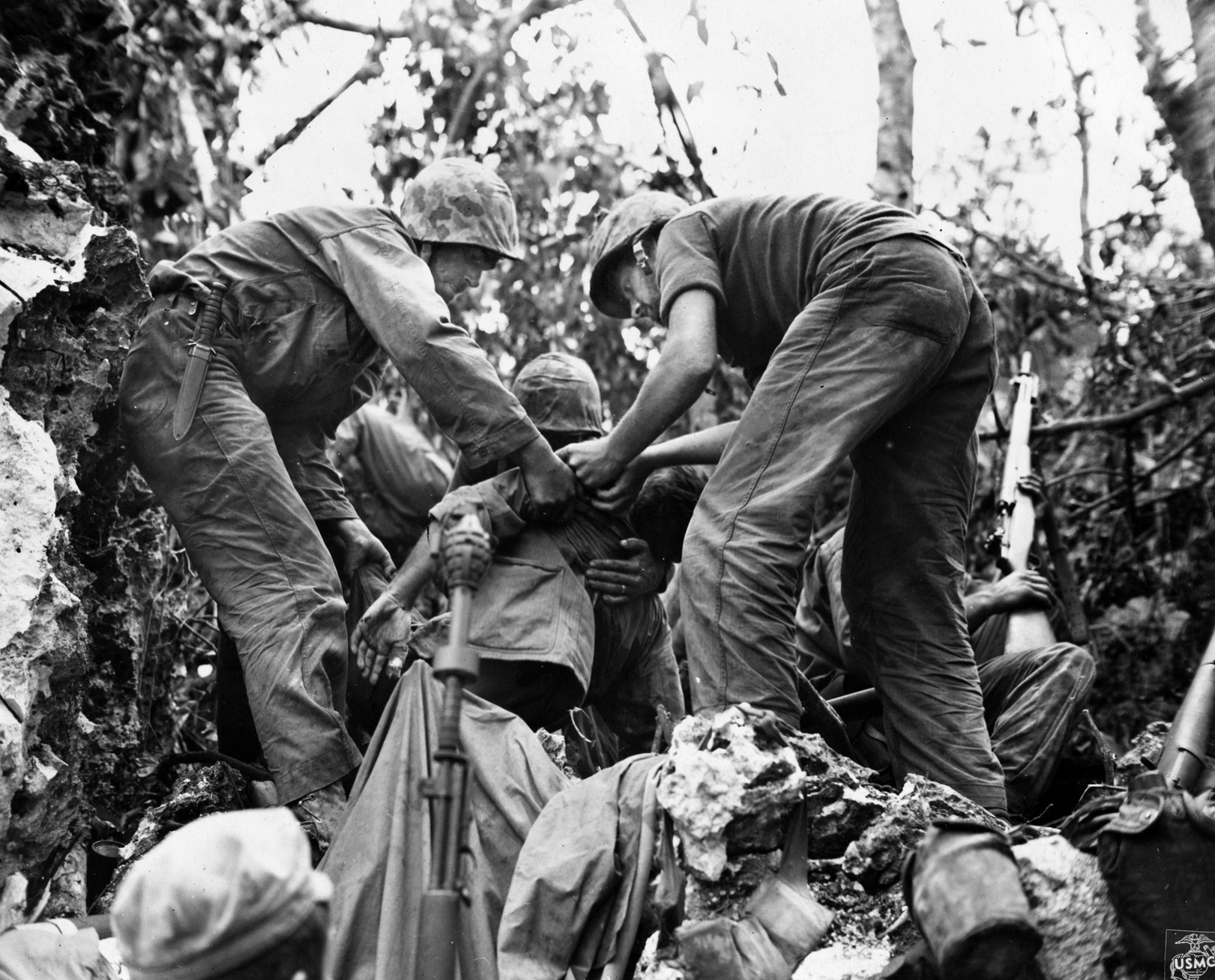
The 1st Battalion, 1st Marines moved forward steadily until confronted by a concrete blockhouse that the Navy had reported destroyed during the pre-invasion bombardment. Obviously, this had not happened, even after the Navy reported it had run out of targets and ceased its bombardment ahead of schedule. The blockhouse was taken only after the 14-inch guns of the battleship Mississippi were directed against its four-foot-thick walls, finally cracking them.
On September 19, Company B, 1st Battalion, 1st Marines attacked Hill 100 near Horseshoe Canyon at the eastern edge of the Umurbrogol. Captain Everett Pope had led 242 Marines ashore; four days later he commanded only 90 effective riflemen. Pope stepped off with tank support but quickly lost it when two Shermans slipped from a narrow causeway as the elevation increased. The Marines pressed on under Japanese small-arms and mortar fire.
When they reached the summit of Hill 100, which the Japanese called East Mountain, Pope’s men came under fire from high ground beyond and from caves that laced a parallel ridge on the western flank that had been dubbed “the Five Brothers.” When night fell, the Japanese began a series of counterattacks to dislodge the Marines, whose ammunition, food, water, and medical supplies were dangerously low. Fighting was hand-to-hand; knives flashed and rifle butts rose and fell. The Marines held on by their fingernails.
Lieutenant Francis Burke and Sergeant James McAlarnis survived a harrowing fight with two Japanese soldiers, one of whom thrust a bayonet into Burke’s leg. The lieutenant killed the enemy soldier with his bare hands, repeatedly pounding him with his fists. McAlarnis crushed the other foe’s skull with his rifle butt. The bodies of the attackers were then unceremoniously tossed down the slope.
As the sun rose, what was left of Company B still held Hill 100, but Pope was down to only eight men. Ordered to withdraw, he evacuated his wounded but had to leave the dead behind. Their bodies were not recovered until two weeks later, when Hill 100 was taken for the last time. Pope received the Medal of Honor for his gallantry.
Aware that the 1st Marines had lost roughly 1,500 killed and wounded by September 19, Maj. Gen. Geiger visited the regiment’s command post on the 21st and discussed the situation with Rupertus and members of his staff. Rupertus was adamant that the Marines did not require Army assistance to capture Peleliu. Geiger, however, had seen enough. He overruled Rupertus, directing the 321st Regimental Combat Team to redeploy from Angaur to Peleliu.
As this was accomplished, Rupertus was ordered to withdraw the 1st Marines. The gallant regiment had virtually ceased to exist as a fighting force, and one veteran of the hellish fight at Peleliu remarked, “I resigned from the human race. We were no longer human beings. I fired at anything in front of me, friend or foe. I had no friends. I just wanted to kill.”
Life magazine war artist Tom Lea accompanied the Marines on Peleliu and produced haunting images that reflected his experience there. One of these depicts a Marine staring with hollow eyes, a victim of days in horrific combat.
“As we passed sick bay, still in the shell hole, it was crowded with wounded, and somehow hushed in the evening light,” Lea captioned the painting, “I noticed a tattered Marine standing quietly by a corpsman, staring stiffly at nothing. His mind had crumbled in battle, his jaw hung, and his eyes were like two black empty holes in his head.”
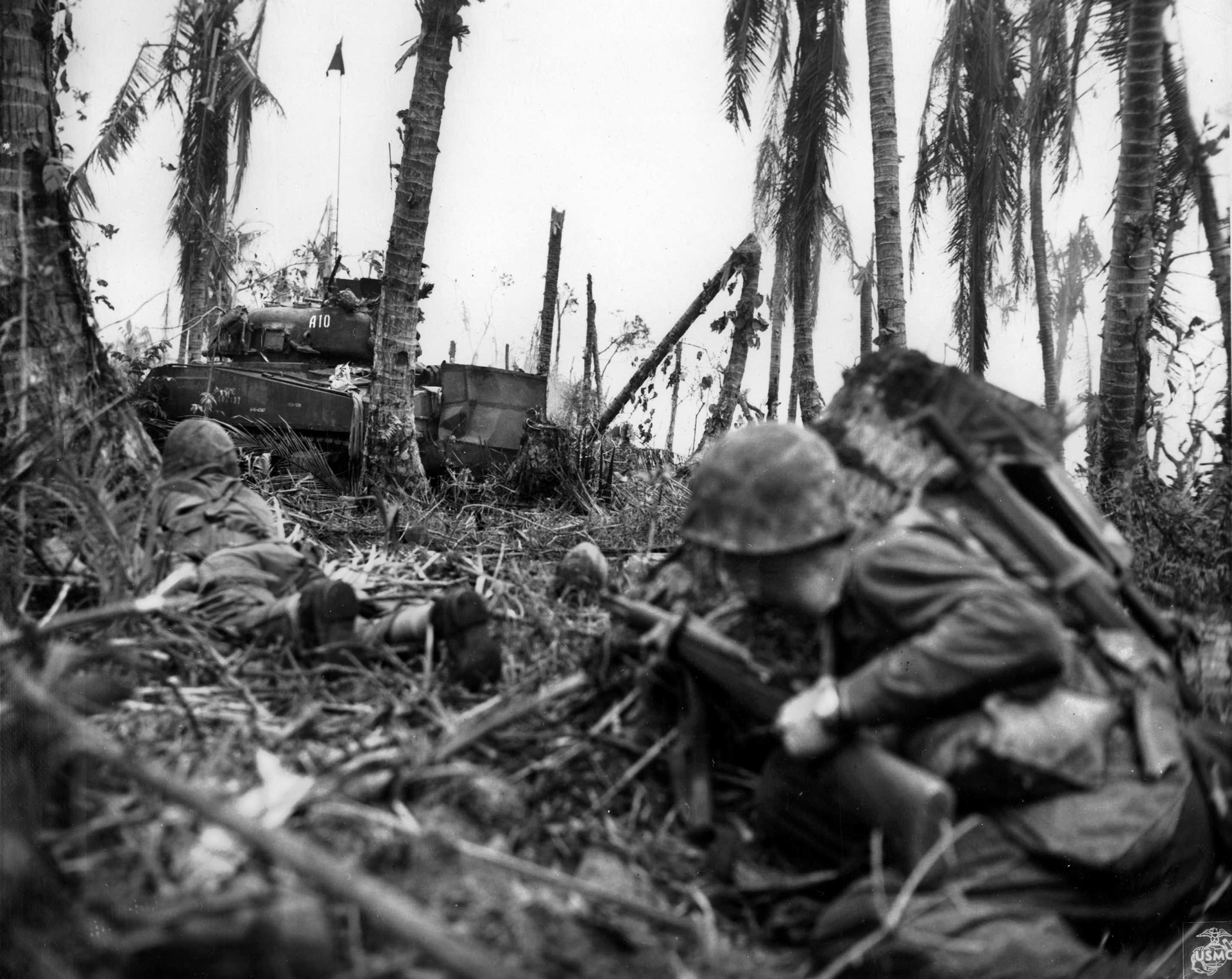
The advance of the 1st Marine Division finally reached the main Japanese line of defense, eliminating several observation posts that the enemy had used to direct artillery fire from the high ground. With the airfield operational, supporting fighter-bombers were now conducting regular missions. Supplies were flowing, but the elimination of Japanese resistance in the Umurbrogol remained an ugly business.
By September 23, the necessity of capturing northern Peleliu was recognized more fully as the Japanese managed to land a battalion of reinforcements from the nearby island of Babelthuap. The arrival of the Army’s 321st Regimental Combat Team from Angaur the following day facilitated operations to isolate the Umurbrogol and secure northern Peleliu. The plan involved a northward advance past the Umurbrogol by the Army troops, with the 5th Marines advancing through them into northern Peleliu as the 7th Marines took over the former positions of the 1st Marines.
Only a single road was available for the movement of tanks and other vehicles, and it was constantly under Japanese fire from the surrounding hills. The advancing troops were often on their own, with only light weapons available.
As Marine Air Group 11 began arriving at the airfield, its fighter-bombers assumed primary responsibility for tactical air support. Major Robert F. “Cowboy” Stout and the pilots of Marine Fighter Squadron 114 (VMF-114) were conspicuous in pressing home their attacks against ground targets.
On September 25, the 5th Marines advanced to the shattered village of Garekoru and secured the neighboring high ground. The following day, the 321st initiated a three-pronged attack on the northern edge of the Umurbrogol, hemming the Japanese into a defensive pocket.
The 5th Marines assaulted the successive promontories of Hills 1, 2, 3, and Radar Hill, known to the Americans as “Hill Row.” Approximately 1,500 Japanese troops occupied these knobs as well as Amiangal Ridge, which extended northward. The 3rd Battalion, 5th Marines captured Hill 80 and reached the eastern shore of Peleliu. On the 27th, the northern portion of the island was effectively secured, although sporadic resistance continued for some time. After four days of combat, the Marines claimed the peaks of Hill Row.
When the 2nd Battalion, 5th Marines assaulted Amiangal Ridge, they requested artillery support, which came from a single barrel of the 8th 155mm Gun Battalion. Japanese observers spotted the weapon on the morning of September 28 and peppered the artillerymen with machine-gun and rifle fire. The incoming Japanese fire was quickly suppressed, and all morning long, the 155mm gun plastered the visible caves and enemy positions along the ridge.
One troublesome strongpoint escaped the rain of shells—the mouth of a large tunnel at the northwestern base of the ridge that was too close to Marine positions for the artillery to fire on. Bulldozers filled in an antitank ditch that blocked the approach to the tunnel, and a combined tank-infantry assault rushed forward to toss demolition charges and fire point-blank into the tunnel mouth. Bulldozers then rolled up and sealed the entrance with mounds of earth and rubble. The Marines seized the crest of Amiangal Ridge, but they remained heavily engaged for some time with the Japanese burrowed inside the warren of tunnels and caves beneath them.
On September 28, the 3rd Battalion, 5th Marines landed on the island of Ngesebus, just 600 yards north of Peleliu, to stifle further Japanese efforts to run more reinforcements down from Babelthuap and capture the airfield. The close-air support of Marine fighter squadron VMF-114, in the first such all-Marine operation of the war, paved the way in the 36-hour fight that subdued 500 Japanese troops.
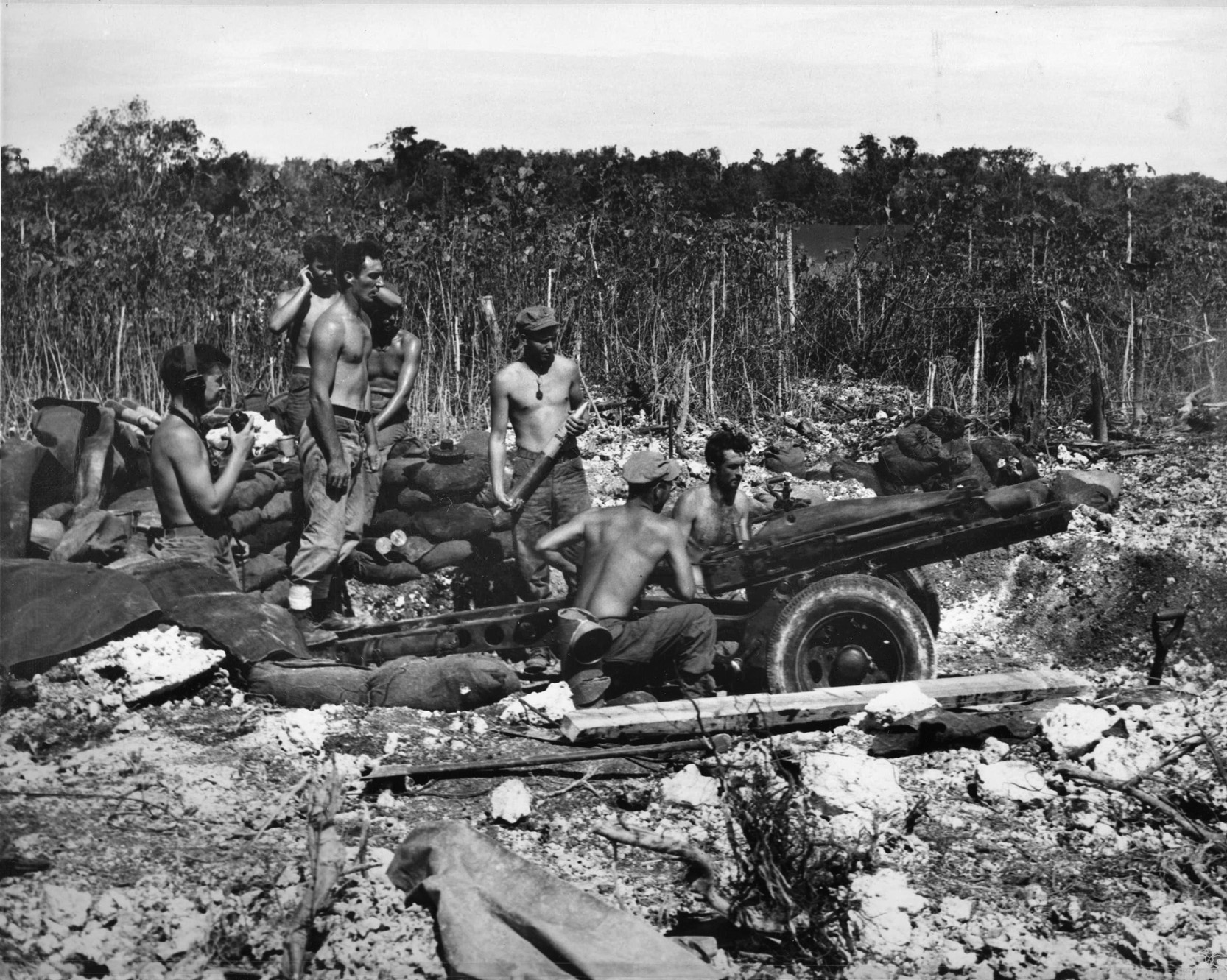
The Umurbrogol Pocket remained defiant, and the Japanese on Peleliu made their last stand there. Stretching about 1,000 yards by 500 yards, the pocket was thick with defenders in well-concealed bunkers, pillboxes, and cave complexes. From the hills nicknamed the Five Sisters in the south to Baldy Hill in the north, the enemy had already exacted a terrible toll. The 1st Marines had begun the dirty job by neutralizing the early threat of artillery fire against the invasion beaches and the Marine movement inland.
Now, the 2nd and 3rd Battalions of the 321st Regimental Combat Team pushed from the north, while the 7th Marines stepped in for the 5th Marines and pressed ahead from the south. The 2nd Battalion, 321st Regiment captured Hill B, at the northern edge of the pocket, on September 26, setting the stage for penetration into the Umurbrogol from the north. On the 29th, the 2nd and 3rd Battalions, 7th Marines relieved the Army troops. To accomplish the transition, ad hoc Marine units were pieced together to maintain the static line previously occupied by the two battalions of the 7th Marines.
With their maneuverability restored, the 2nd and 3rd Battalions of the 7th Marines forged ahead, capturing Boyd Ridge. Recalled from Ngesebus, the 3rd Battalion, 5th Marines came up in support of the 7th Marines on October 3. Although days of combat had reduced each battalion nearly to company strength, the Marines then executed a coordinated assault with four battalions against the eastern and southern sectors of the Umurbrogol Pocket, including Baldy Hill and Hill 300. Simultaneous diversionary attacks were mounted against the cluster of the Five Sisters and Horseshoe Canyon.
The attacks achieved their objectives, with the exception of the 3rd Battalion, 5th Marines’ assault on the Five Sisters. Marine riflemen reached the tops of four of these hills west of Horseshoe Canyon but were forced to withdraw when the fifth was too hotly contested. On the same day, the highest-ranking Marine to lose his life on Peleliu, Colonel Joseph F. Hankins, was killed by a sniper. Hankins had moved down the West Road to sort out a traffic snarl when he was shot.
A renewed effort against the Five Sisters on October 4 was momentarily successful, but the heights had to be abandoned once again. The 3rd Battalion, 7th Marines rushed to the top of Hill 120, and for a time, it was believed that this position could provide a springboard for the seizure of the next ridgeline. But, as was so typical of the fighting on Peleliu, the 3rd Battalion soon found itself under heavy fire, and the Marines were withdrawn.
During the attack on Hill 120, Captain James Shanley, commanding Company L, 3rd Battalion, was killed in action. Shanley dashed from cover to rescue two wounded Marines, dragging them to safety behind a tank, and then went back to save a third. As he stepped forward, an exploding mortar round wounded him fatally. While Shanley lay dying, his executive officer, Lieutenant Harold J. Collins, attempted to reach the captain and was killed by an antitank shell. Shanley received a posthumous gold star for the Navy Cross he had earned at Cape Gloucester.
Two weeks of heavy combat in the Umurbrogol had taken their toll on the 7th Marines, and the attacks of October 4 were its last of the campaign. The 7th Marines had suffered 1,486 casualties, roughly 46 percent of its strength. General Rupertus still wanted the reduction of the pocket to be a Marine affair but acknowledged that the 7th Marines had to be withdrawn; he replaced it with the 5th Marines.
Colonel Harris, the 5th Marines’ commander, had conducted an aerial reconnaissance of Peleliu’s rugged interior during the first week of Operation Stalemate II, prompting him to declare that he intended to be “lavish with ammunition and stingy with…men’s lives.” When Rupertus handed him this latest assignment, Harris viewed the tactical situation as something of a siege. He determined that the Marines held the greatest advantage in the north. The offensive would continue there, while those Marines in the east and south would generally remain in reserve.
Moving into its new positions on October 5, the 5th Marines sent patrols to probe the Japanese defenses and called up bulldozers to carve roads into the box canyons and jungles to the front. Tanks and LVTs equipped with flamethrowers would then be able to provide support to the riflemen.
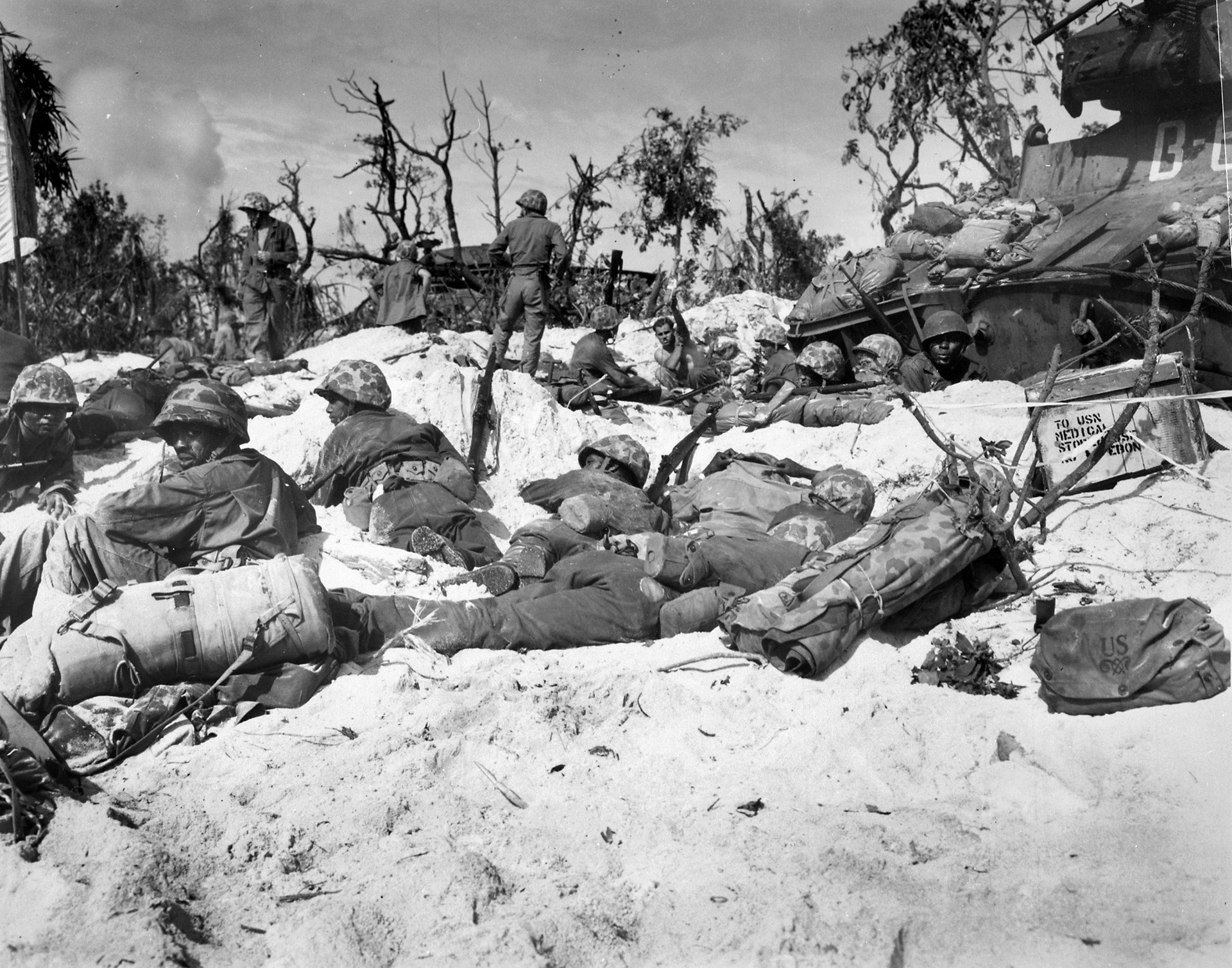
For nearly a week, the 2nd Battalion, 5th Marines fought to take Hill 140, knocking out numerous Japanese positions with satchel charges and hand grenades, while the 3rd Battalion launched a tank-infantry assault into Horseshoe Canyon. The 3rd Battalion’s objective was to clear the stubborn Japanese from the Five Sisters and the lower, western slope of Hill 100. The 2nd Battalion’s capture of Hill 140 signaled the completion of the comprehensive effort.
With Hill 140 in Marine hands, a disassembled 75mm pack howitzer was placed in a sandbag revetment on the West Road, reassembled, and began firing at the mouth of a large cave at the base of the next ridgeline. Repeating this technique with the versatile pack howitzer brought successive Japanese positions under heavy fire, greatly assisting in the capture of hilltops and the clearing of two box canyons that had previously been deathtraps for the Americans. Although the 5th Marines were taking Japanese positions on the western flanks of Boyd Ridge and Walt Ridge under fire, the enemy troops were still protected by a series of guns along the Five Brothers.
In mid-October, the 3rd Battalion, 5th Marines was ordered to relieve the spent 2nd Battalion. The slow but steady collapsing of the Umurbrogol Pocket, which had thus far reduced the enemy perimeter 500 yards to the south, meanwhile continued. The Japanese enclave was now only 800 yards wide by 500 yards long. For all practical purposes, enemy resistance was contained to that area, and Peleliu was secured.
Rupertus, however, remained fixated on the Marines completing the conquest of the Umurbrogol. That is, until a pair of significant events compelled him to relent to those, including Maj. Gen. Geiger, who urged that the 5th and 7th Marines should be withdrawn from the fighting altogether and that Maj. Gen. Mueller’s 81st Infantry Division should complete the assignment. First, the 81st Division’s 323rd Regimental Combat Team returned from the capture of the island of Ulithi and brought the division to full strength. Second, a communique from Admiral Nimitz at far-off Pearl Harbor proclaimed that Peleliu was secure and further instructed Geiger to turn over tactical command to Mueller.
On October 15-16, the relief of the remnants of the 1st Marine Division was accomplished. Four days later, Mueller established his command post on southeast Peleliu.
For six more weeks, the troops of the Army’s 81st Infantry Division methodically destroyed Japanese strongpoints, particularly in the vicinity of the Five Brothers, Five Sisters, and a formidable rise called the “China Wall.” Army engineers used satchel charges and flamethrowers to root the enemy soldiers out, entomb them, or burn them alive.
Nakagawa sent his last message to superior officers on the island of Koror on November 24, advising, “Our sword is broken. We have run out of spears.” He further related that he had burned the colors of the 2nd Infantry Regiment and that the handful of troops who remained at his disposal were being grouped into infiltration teams “to attack the enemy everywhere.“ After dark, 25 Japanese soldiers were killed attempting to slip through the American lines. When daylight came, a prisoner informed his Army captors that Nakagawa had committed suicide.
On the 74th day of Operation Stalemate II, American troops converged from north and south and linked up near the site of Nakagawa’s former headquarters. Isolated pockets of Japanese resistance took many more days to clear, but the horrific battle for Peleliu was effectively over.
Along with Captain Pope, seven more Marines received the Medal of Honor for valor on Peleliu. Corporal Louis Bausell, Pfcs. Richard Kraus, Charles Roan, and John D. New, and Private Wesley Phelps smothered hand grenades to save their comrades, while 1st Lt. Carlton Rouh was seriously wounded when he placed himself between his men and the blast of another grenade. Private First Class Arthur Jackson was credited with destroying 12 fortified Japanese positions and killing 50 enemy soldiers singlehandedly on September 18. Rouh, Pope, and Jackson survived the battle to receive their medals.
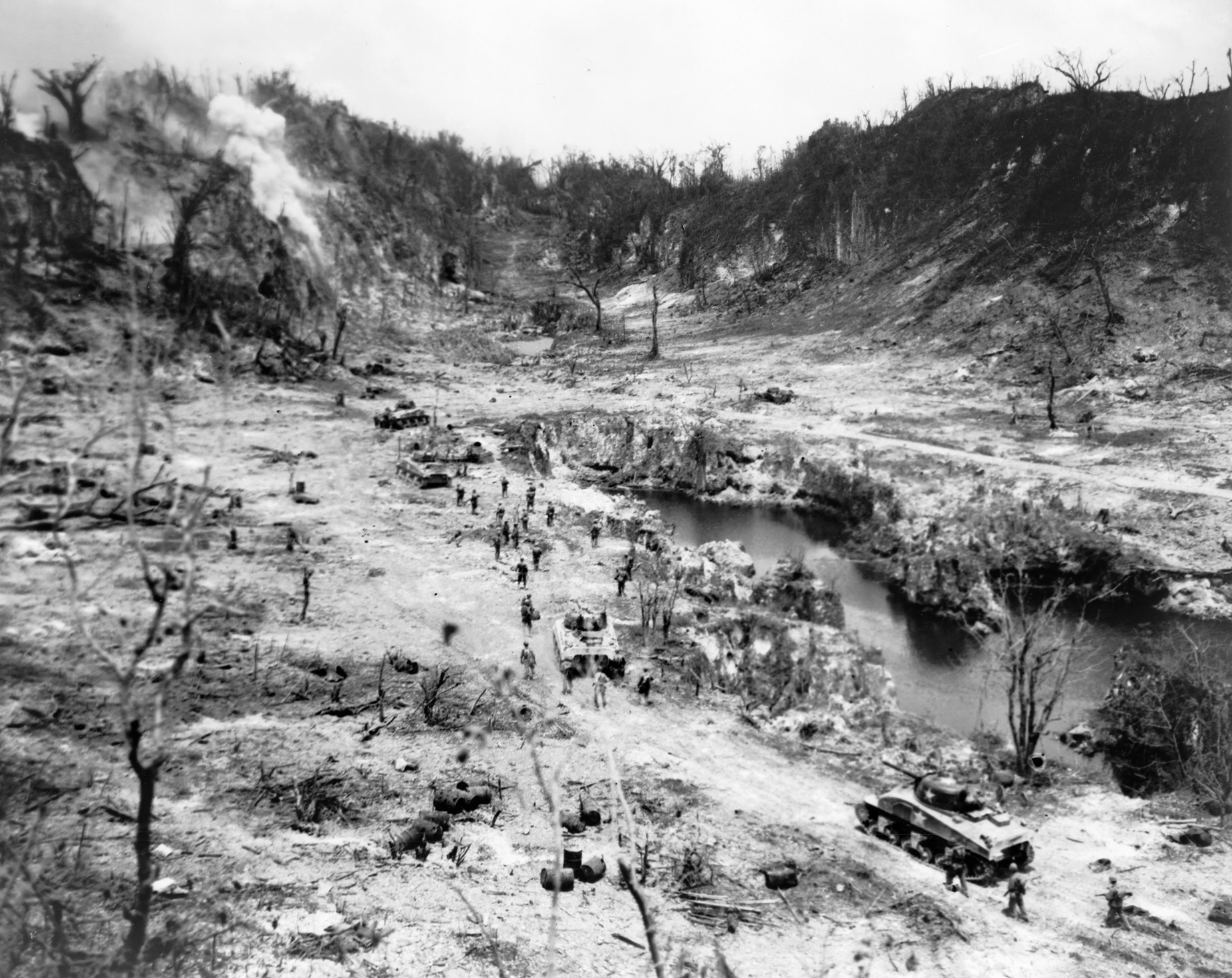
The fight for Peleliu had shattered the 1st Marine Division, which absorbed 1,300 dead and 5,450 wounded, while 36 Marines were missing in the deep jungle. The 81st Division lost more than 3,000 casualties on Peleliu and Angaur, 468 of them killed. The Japanese garrison on Peleliu and the surrounding islands was annihilated. Only 241 prisoners were taken, and of the 202 captured on Peleliu, just 19 were Japanese. The remainder were Korean and Okinawan laborers.
Was possession of Peleliu worth the cost? The debate continues to this day. Because of assurances that the campaign would conclude swiftly, only six reporters accompanied the Marines to the island, and the brutal battle received scant news coverage. MacArthur’s looming return to the Philippines also relegated the operation to the back pages of American newspapers.
In the years after World War II, Nimitz never fully explained his decision, although it can be concluded with certainty that he did not allow the invasion to proceed for personal glory or pride, as other senior commanders might have done. Still, some historians have called Operation Stalemate II the admiral’s great mistake of the Pacific War.
The real payoffs for the bloodshed at Peleliu lay in its future use as a base for American bombers to strike the Philippines; as the cork in the bottle that isolated 250,000 Japanese troops on other islands in the Carolines; and in the invaluable lessons learned in tank-infantry coordination and the subduing of fixed, in-depth fortifications. These lessons would be applied in the future at Okinawa, but, sadly, there was no time to impart the hard-won wisdom to the Marines of the V Amphibious Corps, ordered to take the island of Iwo Jima to the north a few weeks after major combat operations on Peleliu ended.
Eclipsing any other conclusions, the battle for Peleliu validated the combat prowess, dedication, and pure heroism of the United States Marines and confirmed the honor and prestige of the 1st Marine Division for all time. For many, though, the American victory at Peleliu has remained a pyrrhic one.
Michael E. Haskew is the editor of WWII History Magazine and the author of numerous book and articles on varied historical topics. He resides in Chattanooga, Tennessee.
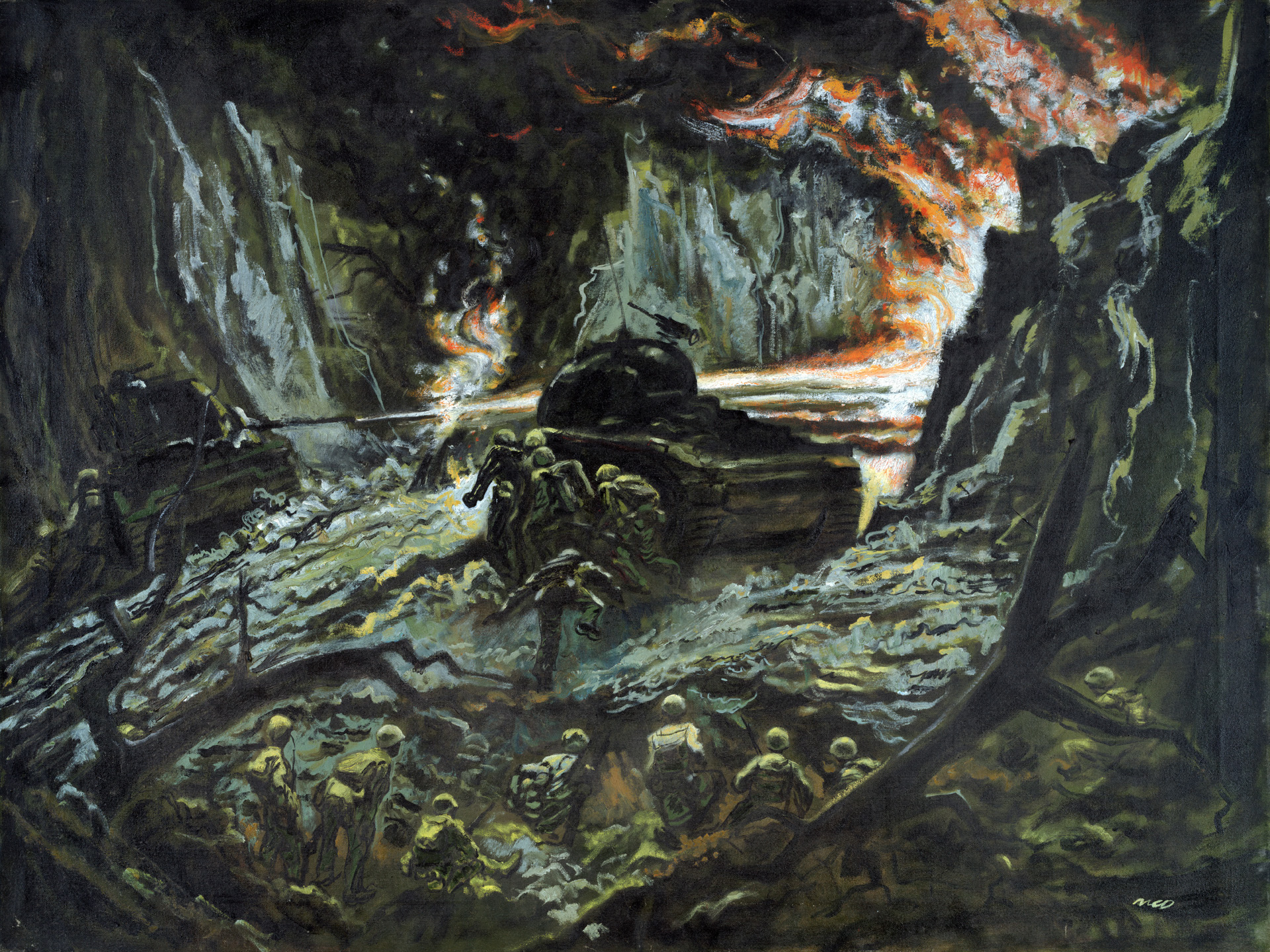
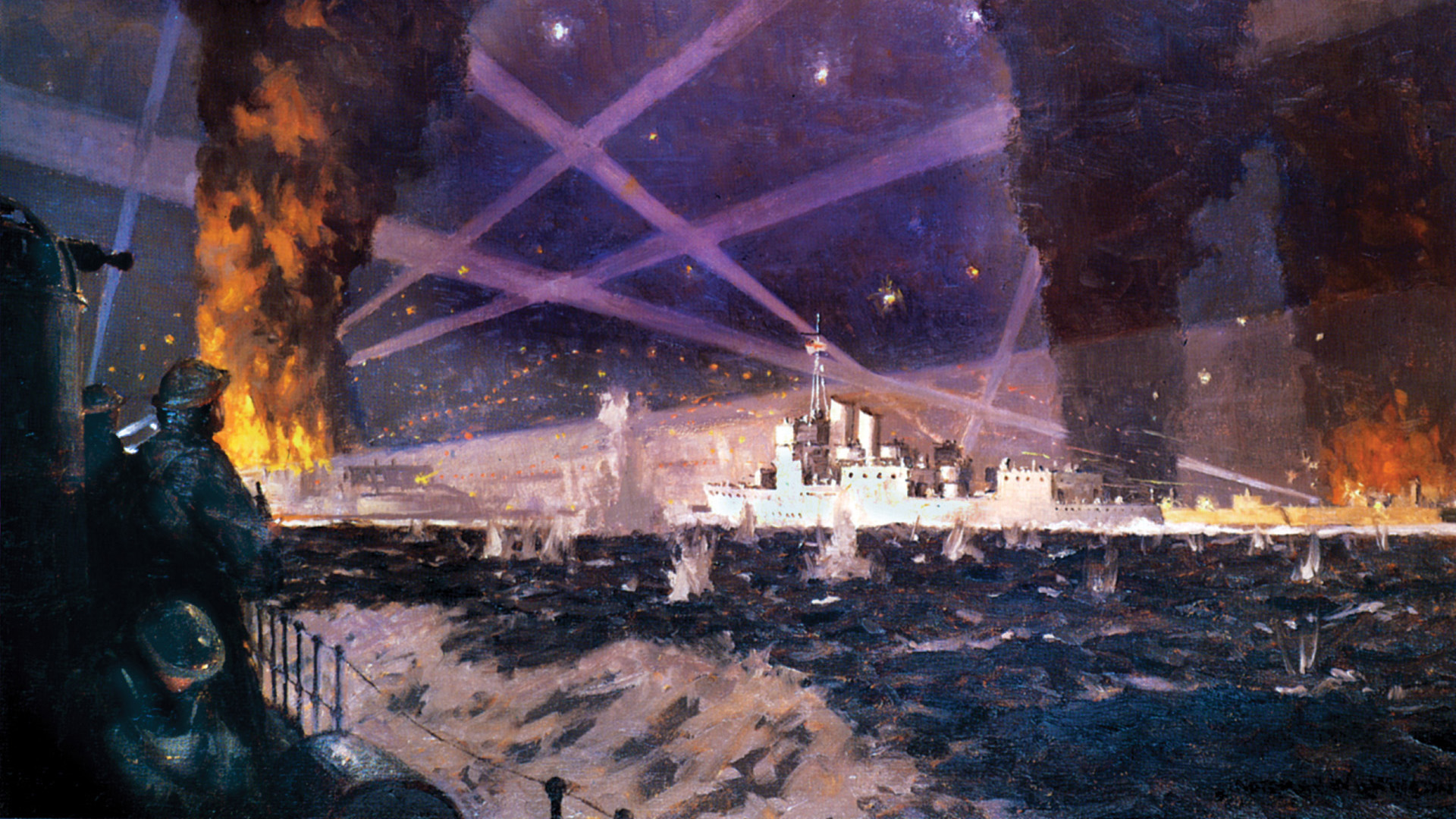
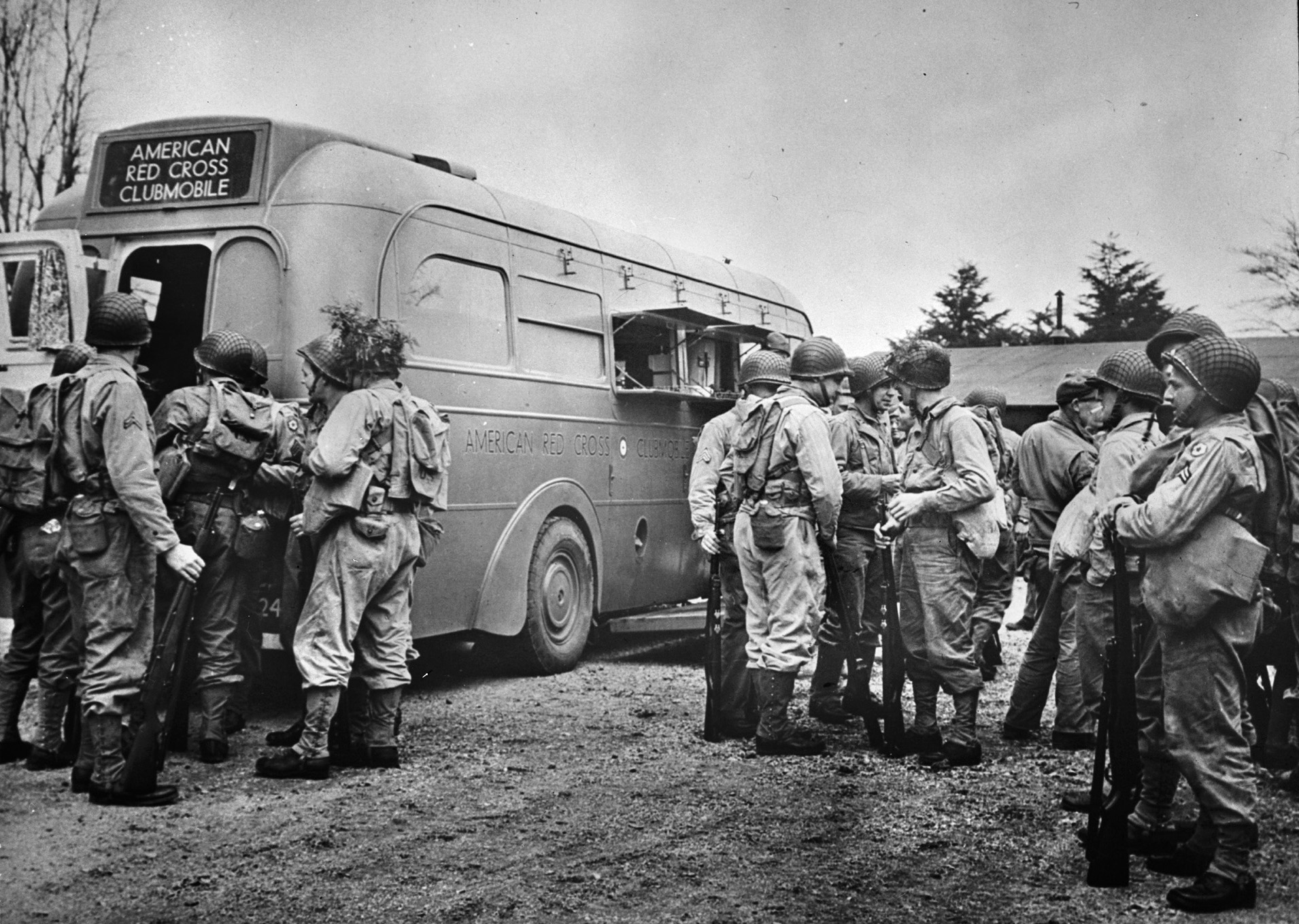
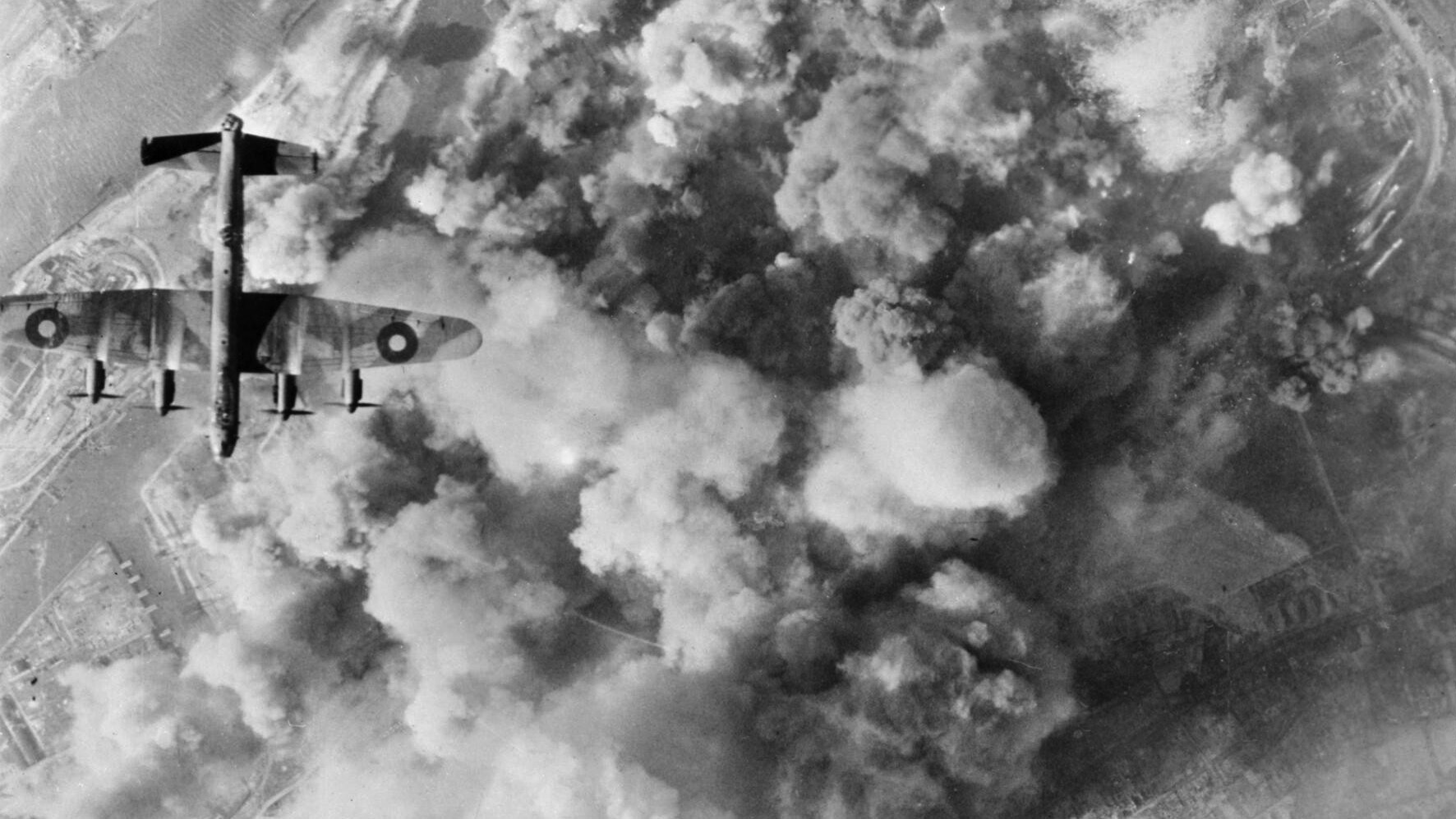
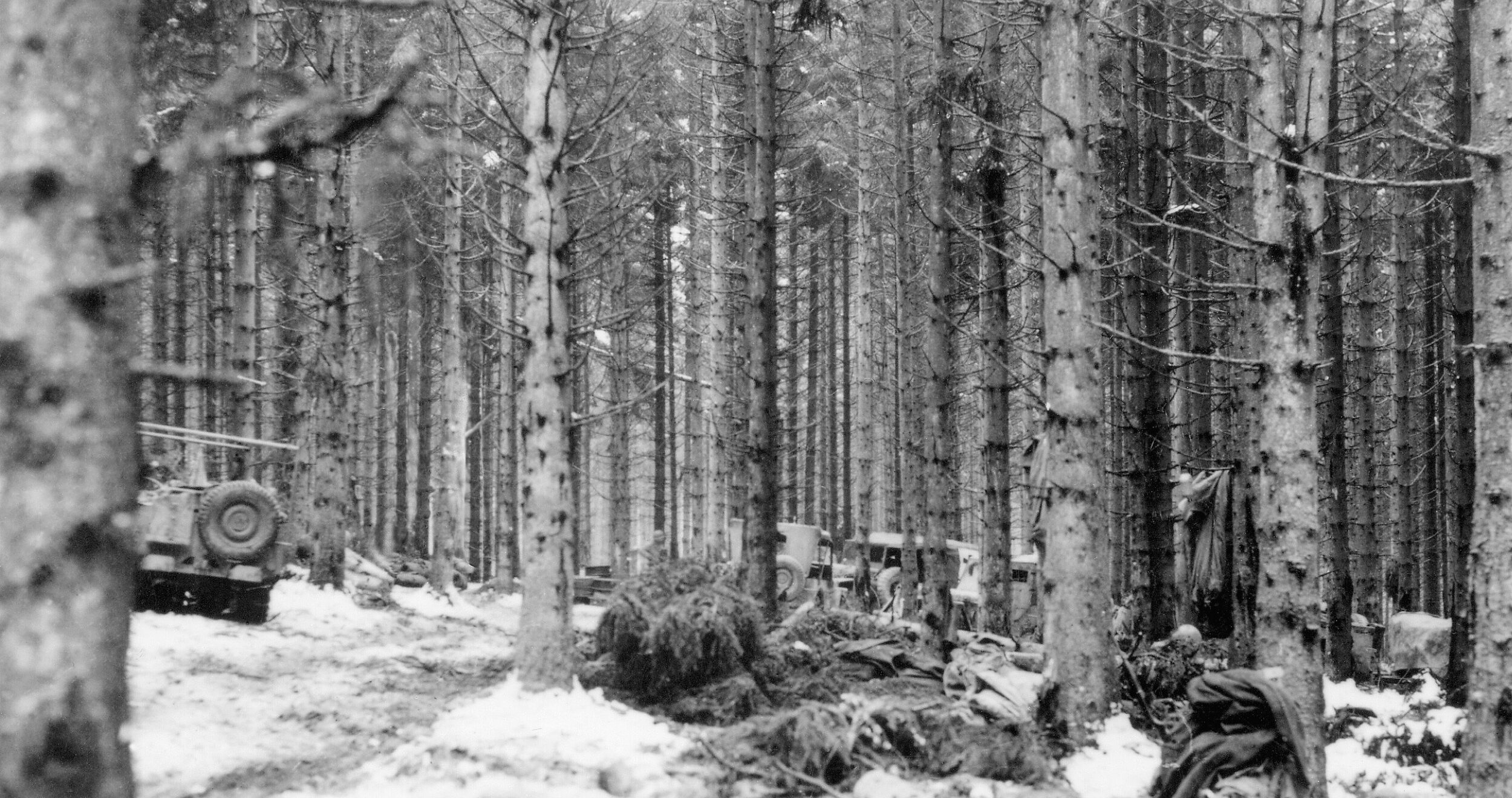
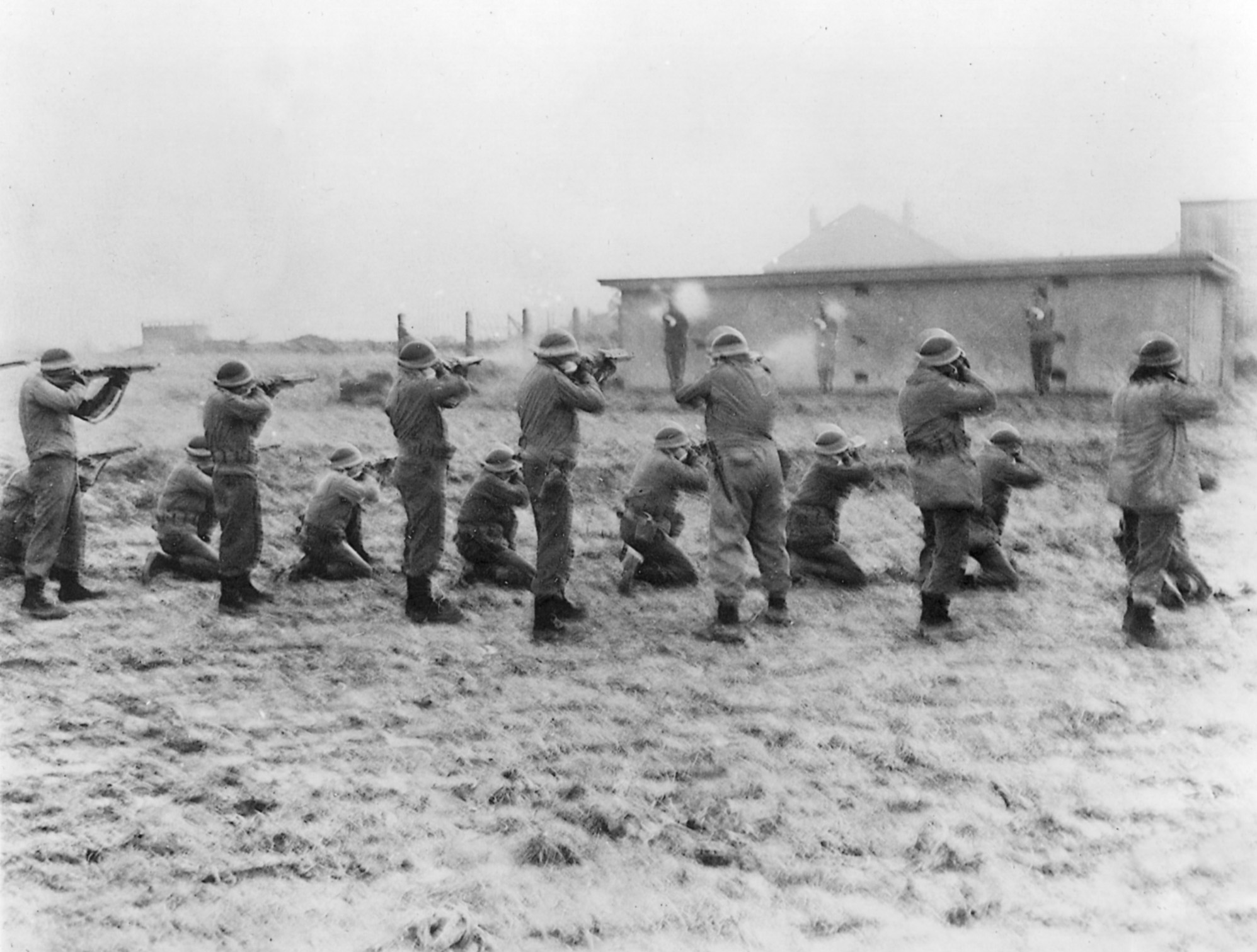
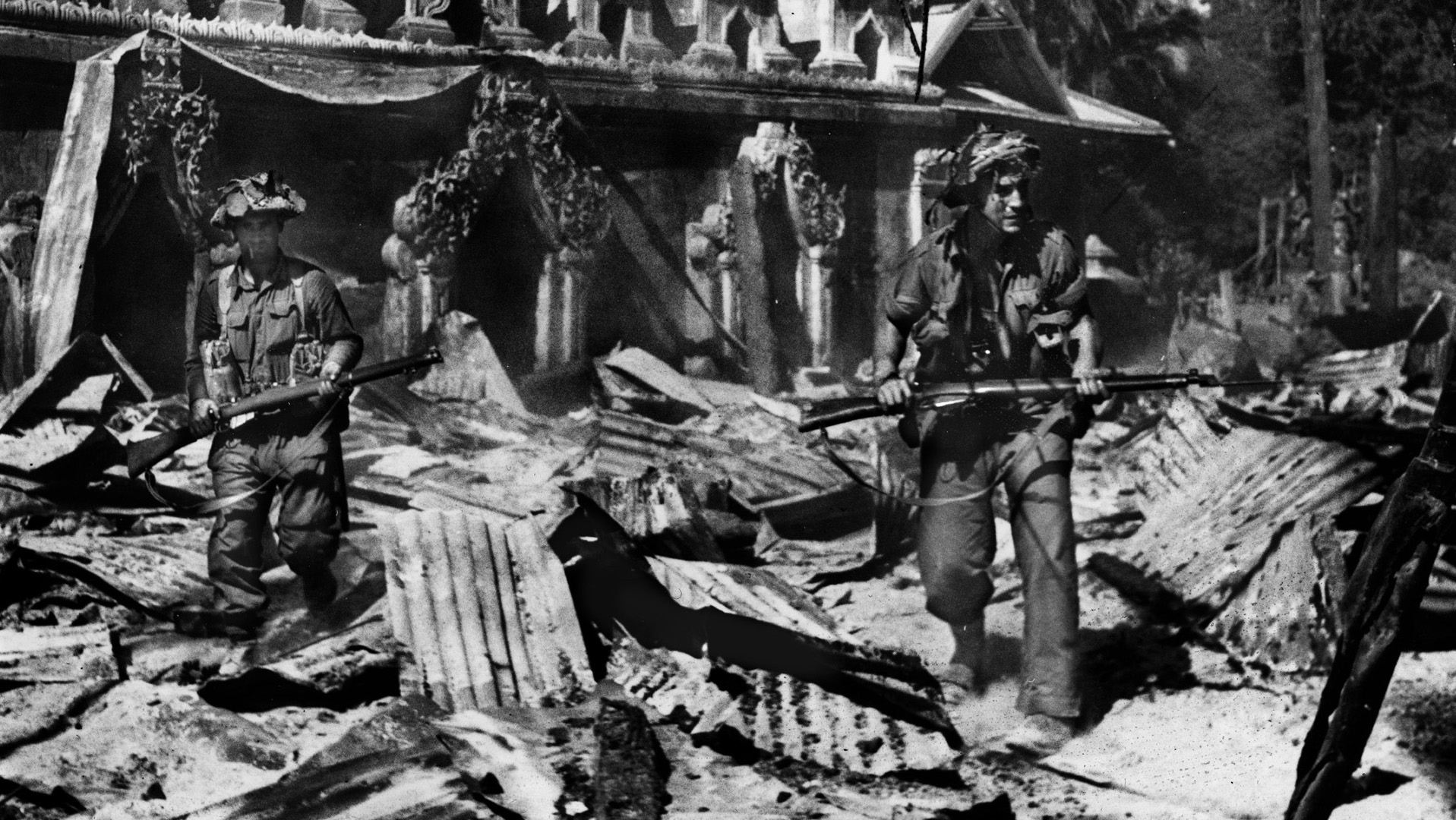
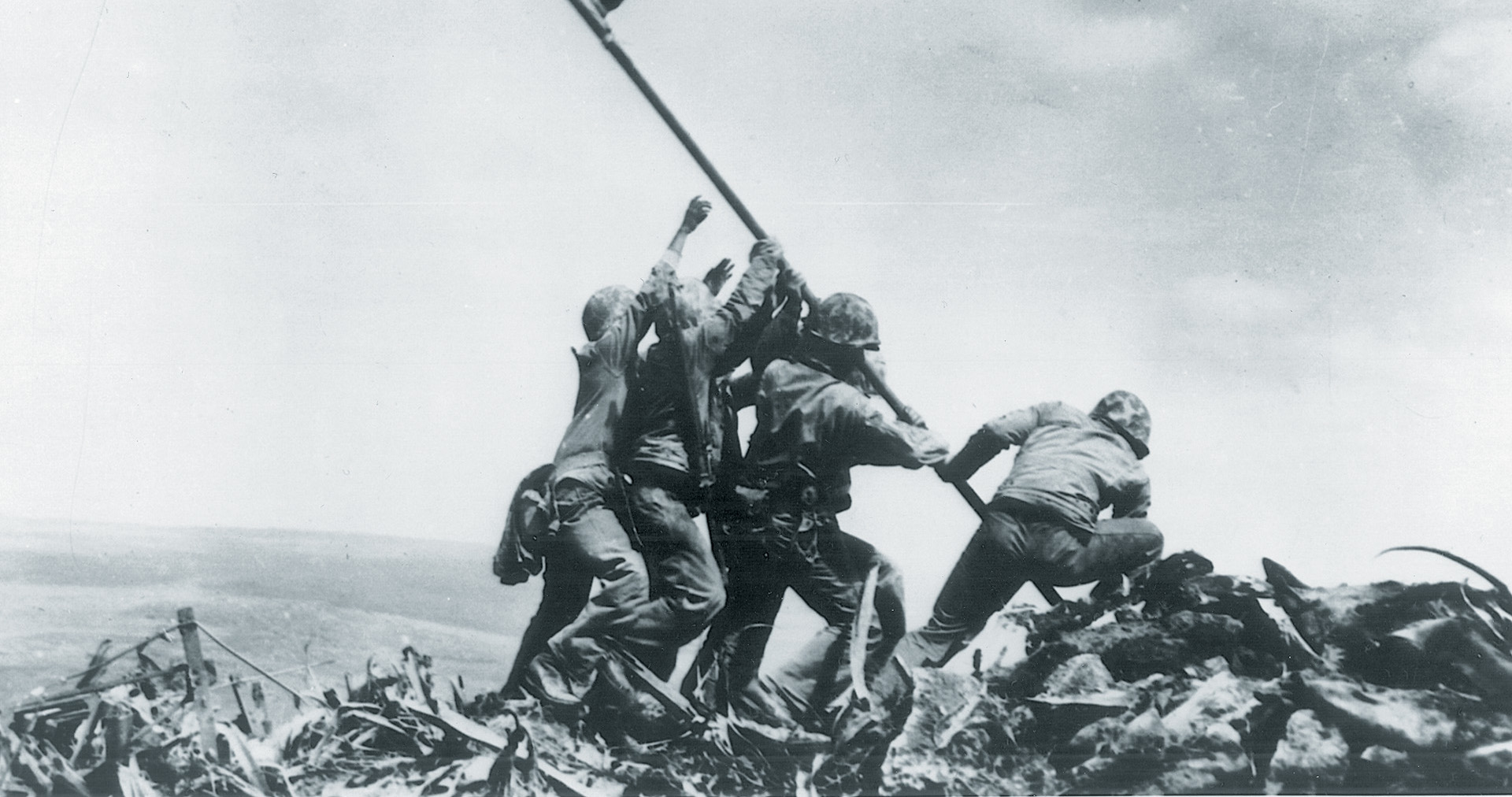
Peleliu and probably Tarawa were two islands that probably could have been bypassed as there was no real way they could have been supported by the Japanese at that point in the war. This was well known to military planners but ignored by the theater commanders. There were other locations quite suitable for conducting air operations against the Japanese, particularly since their air force had been reduced in both size and the quality of its pilots. All things considered, a highly questionable operation for the price that was paid.
I agree with you 100% Donald. Having read Ian W. Toll’s outstanding trilogy about the war in the Pacific and Walter R. Borneman’s excellent book, “MacArthur at War”, I think Admiral Chester Nimitz made a terrible decision to attack these islands with ground troops, especially by frontal assaults, as opposed to letting them “wither on the vine” as General Douglas MacArthur did with various Japanese strongholds on the east coast of Papua/New Guinea by simply going around them. I believe Admiral Nimitz regretted his decisions when the casualty numbers came in; unfortunately, it was too late by then to undo the damage.